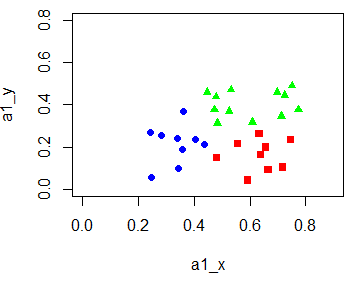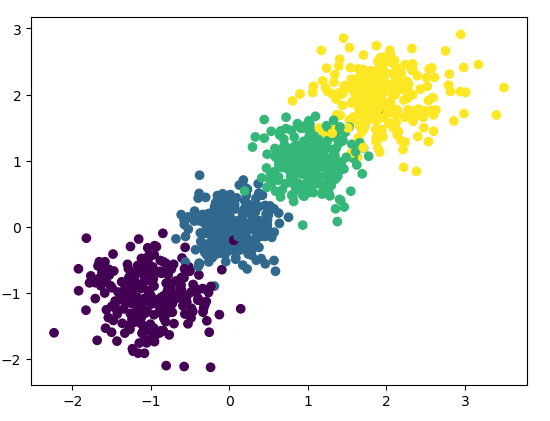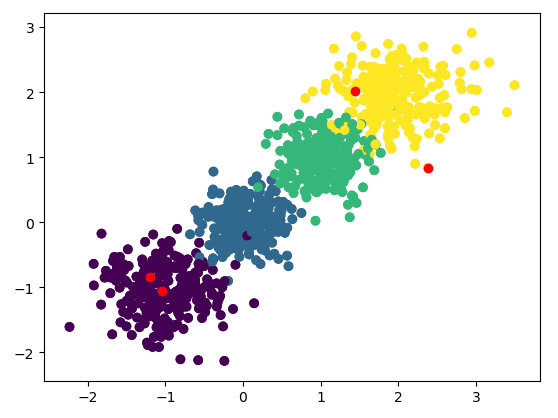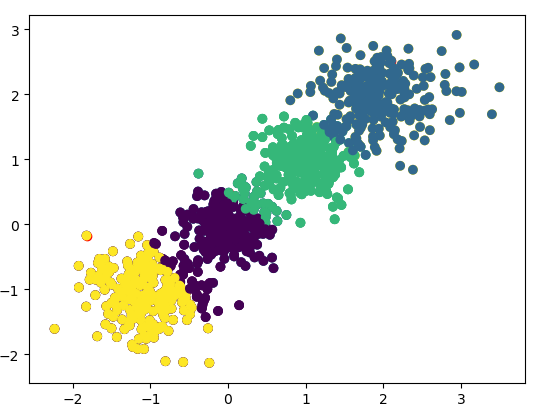python 聚类分析 k均值算法
dataSet = [ #数据集
# 1
[0.697, 0.460],
# 2
[0.774, 0.376],
# 3
[0.634, 0.264],
# 4
[0.608, 0.318],
# 5
[0.556, 0.215],
# 6
[0.403, 0.237],
# 7
[0.481, 0.149],
# 8
[0.437, 0.211],
# 9
[0.666, 0.091],
# 10
[0.243, 0.267],
# 11
[0.245, 0.057],
# 12
[0.343, 0.099],
# 13
[0.639, 0.161],
# 14
[0.657, 0.198],
# 15
[0.360, 0.370],
# 16
[0.593, 0.042],
# 17
[0.719, 0.103],
# 18
[0.359, 0.188],
# 19
[0.339, 0.241],
# 20
[0.282, 0.257],
# 21
[0.748, 0.232],
# 22
[0.714, 0.346],
# 23
[0.483, 0.312],
# 24
[0.478, 0.437],
# 25
[0.525, 0.369],
# 26
[0.751, 0.489],
# 27
[0.532, 0.472],
# 28
[0.473, 0.376],
# 29
[0.725, 0.445],
# 30
[0.446, 0.459]
]
# print(len(dataSet))
# print(dataSet)
# '''
m = len(dataSet) #存储dataSet的长度
# print(m)
k = int(input("请输入簇数:"))
miu = [] #用于存储均值向量
choice = sample(list(range(m)),k) #从列表中随机抽样k个元素
miu = [dataSet[i] for i in choice] #初始化均值向量
# print("μ:\n{}".format(miu))
times = 0
while True:
times = times+1
if times>100:
print("循环次数过多")
break
a = [[] for i in range(k)] # 用于存储样本与各均值向量的距离
# print(a)
for j in range(m): # 计算xj与各均值向量μi的距离
bar = 1000000000000000000000 #聚类比较值
biaoji = -1 # 簇标记
for i in range(k):
dis = np.hypot(dataSet[j][0]-miu[i][0],dataSet[j][1]-miu[i][1])
if dis<bar:
bar = dis; biaoji = i
a[biaoji].append(dataSet[j]) #根据距离最近的均值向量确定xj的簇标记
# print("簇0\n{}".format(a[0]))
# print("簇1\n{}".format(a[1]))
# print("簇2\n{}".format(a[2]))
miu1 = [[] for i in range(k)] #重新计算均值向量
for i in range(k):
miu1[i].append(np.sum([a[i][j][0] for j in range(len(a[i]))])/len(a[i]))
miu1[i].append(np.sum([a[i][j][1] for j in range(len(a[i]))])/len(a[i]))
if miu==miu1: #如果前后均值向量相等,跳出
break
else:
miu = miu1
# break
print("循环次数:\n{}".format(times))
print("簇0\n{}".format(a[0]))
print("簇1\n{}".format(a[1]))
print("簇2\n{}".format(a[2]))
其中得到的一组结果:
x1 = [[0.634, 0.264], [0.556, 0.215], [0.481, 0.149], [0.666, 0.091], [0.639, 0.161], [0.657, 0.198], [0.593, 0.042], [0.719, 0.103], [0.748, 0.232]] x2 = [[0.403, 0.237], [0.437, 0.211], [0.243, 0.267], [0.245, 0.057], [0.343, 0.099], [0.36, 0.37], [0.359, 0.188], [0.339, 0.241], [0.282, 0.257]] x3 = [[0.697, 0.46], [0.774, 0.376], [0.608, 0.318], [0.714, 0.346], [0.483, 0.312], [0.478, 0.437], [0.525, 0.369], [0.751, 0.489], [0.532, 0.472], [0.473, 0.376], [0.725, 0.445], [0.446, 0.459]] [0.46, 0.376, 0.318, 0.346, 0.437, 0.369, 0.489, 0.472, 0.376, 0.445, 0.459]
用R作图:
a1_x = c(0.634, 0.556, 0.481, 0.666, 0.639, 0.657, 0.593, 0.719, 0.748) a1_y = c(0.264, 0.215, 0.149, 0.091, 0.161, 0.198, 0.042, 0.103, 0.232) a2_x = c(0.403, 0.437, 0.243, 0.245, 0.343, 0.36, 0.359, 0.339, 0.282) a2_y = c(0.237, 0.211, 0.267, 0.057, 0.099, 0.37, 0.188, 0.241, 0.257) a3_x = c(0.697, 0.774, 0.608, 0.714, 0.483, 0.478, 0.525, 0.751, 0.532, 0.473, 0.725, 0.446) a3_y = c(0.46, 0.376, 0.318, 0.346, 0.312, 0.437, 0.369, 0.489, 0.472, 0.376, 0.445, 0.459) plot(a1_x,a1_y,pch = 15,xlim = c(0,0.9),ylim = c(0,0.8),col = "red") points(a2_x,a2_y,pch = 16,col = "blue") points(a3_x,a3_y,pch = 17,col = "green")

#老师的代码,时间复杂度很低: ''' 1.对簇中心进行循环 2.利用numpy包的函数进行运算 '''
from sklearn.datasets.samples_generator import make_blobs import numpy as np import matplotlib.pyplot as plt
#生成数据 X,y = make_blobs(n_samples=1000,n_features=2,centers=[[-1,-1],[0,0],[1,1],[2,2]],cluster_std=[0.4,0.3,0.3,0.4],random_state=7) plt.scatter(X[:,0],X[:,1],c = y) plt.show()

#k-means聚类 n_cluster = 4 #聚类簇数 n = len(X) #散点个数 dist = np.zeros((n,n_cluster)) #存放各点到簇中心点的距离 sample_index = np.arange(n) cluster_center = X[np.random.choice(sample_index,n_cluster),:] #随机选取簇中心点 new_cluster_center = np.zeros((n_cluster,2)) #存放簇中心坐标
plt.scatter(X[:,0],X[:,1],c=y) plt.scatter(cluster_center[:,0],cluster_center[:,1],c = 'red') plt.show()

ISok = False
time = 0
while not ISok:
time = time + 1
if time>100:
break
#计算每个点到簇中心的距离
for i in range(n_cluster):
# dist[:,i] = np.sqrt(np.sum((X - cluster_center[i,:])**2,axis=1)) #存储各点到簇中心的距离
dist[:, i] = np.hypot(X[:, 0] - cluster_center[i, 0], X[:, 1] - cluster_center[i, 1])
#将数据点放进与其最近的簇
ClassID = np.argmin(dist,axis=1) #存储与数据点最近的簇中心编号
#计算新的簇中心
for i in range(n_cluster):
Classmask = (ClassID == i) #提取每个数据点的布尔值,也就是这个点属于第i簇布尔值为True
new_cluster_center[i,:] = np.average(X[Classmask,:],axis = 0) #计算新的簇中心
e = np.sum(np.sqrt(np.sum((new_cluster_center - cluster_center) ** 2, axis=1)))
# print(e)
if e < 1e-6 :
ISok = True
else:
cluster_center = new_cluster_center
print("运行了{}次".format(time))
plt.scatter(X[:,0],X[:,1],c = ClassID)
plt.show()






